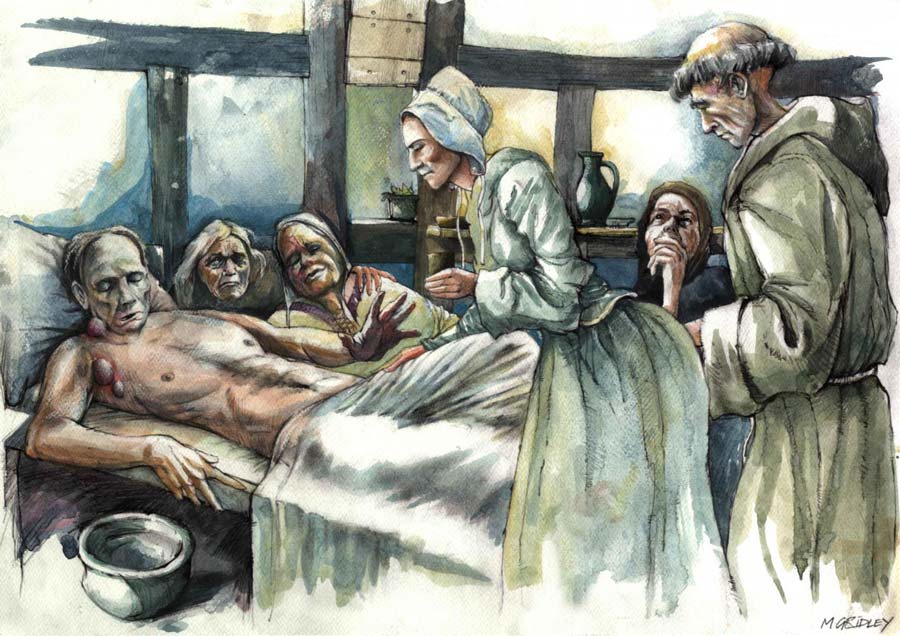Plague Victims In Medieval Cambridge Treated With Care and Compassion
“Yersinia Pestis,” the killer pathogen that causes plague, was identified in bodies dated to the medieval period in Cambridgeshire, England. A new study of these corpses confirms for the first time that many plague victims were not carelessly buried in mass graves but instead treated with compassion and care under the most testing times imaginable.
The Black Death swept across Europe in the mid-14th century killing about half of the continent’s population. Up to now mass graves were the sole repository for archaeologists to source samples of plague victims in England, however, a new paper published in the European Journal of Archaeology explains that researchers have long suspected that most plague victims were buried individually. Now, this has finally been confirmed.

According to the latest research paper, plague victims were often individually buried with care and compassion, which was determined by analyzing their teeth calculus. (European Journal of Archaeology)
Medieval Plague Victim’s Tooth Calculus Tells Us More!
Up until about 10 years ago the number one clue sought after by investigators of any kind when trying to reason why someone did something, or figure out what happened in any given situation, was the fingerprint. Now, “teeth,” are the new fingerprints as modern analytical technologies are able to micro-analyze the DNA gathered from tooth calculus.
- 1,000-year-old tooth plaque sheds light on ancient lives
- Details of First Historically Recorded Plague Pandemic Revealed by Ancient Genomes
A team of scientists from the Department of Archaeology at the University of Cambridge’s “After the Plague project” identified the presence of “Yersinia Pestis,” the pathogen which sparks the growth of plague on several bodies that had “received normal burials” at a parish cemetery and friary in Cambridge and in the nearby village of Clopton. This discovery contravened the traditional assumption that most plague victims were disposed of in mass burial pits.

These plague victims from Cambridgeshire, England were individually buried and treated with compassion and care, according to the latest study. (European Journal of Archaeology)
Many, But Not All Plague Victims Received Care and Compassion
In 2017, on behalf of Corpus Christi College, the Cambridge Archaeological Unit conducted excavations on this friary site. Professor Craig Cessford of the University of Cambridge explained that the people's bodies that had been individually buried, even when they were already infected with the plague. This finding, according to the lead scientist, “demonstrated considerable care and attention” shown to those who were suffering from the horrible infection.
This unexpected result was found to be particularly true at the friary where at least three such individuals were buried within the chapter house. This shows that “care and compassion” was extended even to those with bubbling skin suffering the horrors of the plague, according to the new paper. This particular area of graves was afterwards transferred to Corpus Christi College, which was founded by the St Bene’t’s parish guild, “to commemorate the dead including the victims of the Black Death,” according to the paper.
Therefore, ironically, for centuries, thereafter the members of the College would walk over the medieval plague victim burials every day on their way to the parish church to pray for God’s protection from pestilence.

An ancient book illustration (parchment style) from the medieval period when plague victims piled up all over Europe. Now the latest research from England's early plague victims indicates there was more care and compassion in handling the dead than was previously assumed. (Matrioshka / Adobe Stock)
Care And Compassion Comes Naturally To Humans
These new finding contravene the “chuck and bury” brutality that has been associated with mass burials. It could be argued that one would expect a higher degree of compassion to be shown to people buried at a friary, but a body recovered in the parish of All Saints, by the Castle in Cambridge, was also carefully “and compassionately” buried.
- Blue Pigment Found on Medieval Teeth Reveals Secret Existence of Female Scribes
- The Black Death: the Plague that Sowed Terror and Death in Medieval Europe - Part 1
The paper says these findings contrast with the “apocalyptic language used to describe the abandonment of this church in 1365 AD when it was reported that the church was partly ruinous and 'the bones of dead bodies are exposed to beasts’.”
The new study is not saying all plague victims were buried in beds of roses in private burials, because it also shows that many of Cambridge’s plague victims were disposed of in mass burials. Dr Cessford says this new work makes it possible for future investigators to identify individuals who died from plague and received individual burials, which until now had not been possible.
The takeaway from this new study is twofold in that on one hand researchers now know an awful lot more about the plague in Cambridge than they did previously. But on a more global note, these results demonstrate that even when groups of humans and communities are being torn apart by bacterial demons, the victim’s dignity was preserved not only in their last spluttering breaths on this Earth, but also in the afterlife. For without a care of what happened thereafter, everyone would have been dumped in mass graves, and none of these individual graves would have been discovered.
Top image: Reconstruction of plague victims being cared for at All Saints Church, Cambridge. Source: Mark Gridley / European Journal of Archaeology
By Ashley Cowie



















